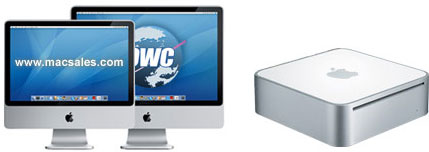|
 Upgrading Memory in your Upgrading Memory in your
iMac Intel (Mid 2007) or Mac mini (Mid 2007)
"To Pair or Not to Pair" - part in a continuing series (Updated August 16th, 2007)
In December of 2006, we did testing to establish why Apple had recommended Pairs for MacBook, Mac mini, and certain iMac models. The models Apple recommends paired memory for all have the Intel GMA950 integrated video chipset in common. Of note is that rather than having its own dedicated Video Memory, the GMA950 shares its 64MB VRAM allocation for the main system memory.
All of Apple's current Core 2 Duo Models (same is true between Core Duo equipped Mac models) share the same processor bus and memory controller. It is only the models with GMA950 which Apple recommends the pairs for and from that we'd infer the recommendation is related to impact on video performance.
The bottom line? The results of our testing did not support Apple's recommendation and rather make it very clear that in addition to the potential economic advantages, there are real performance advantages to having more memory - even if it means not having a pair. It is our recommendation to upgrade memory, be it one at a time or with a pair, or to 4.0GB - based on what you need and what your budget allows.
*See original December 2006 article*
The tests that follow show the performance of different paired and non-paired memory configurations.
NOTE: A 4.0GB (2GB x 2 Pair) configuration was also tested by 'popular demand' in the Mac mini. Although the Core 2 Duo Mac mini is limited to 3.0GB addressed, the 4GB Set (2GB x 2 Pair) does appear enable 128 Bit addressing. While there does seem to be a small performance benefit gained with the 4.0GB vs. 3.0GB config, we'd recommend sticking with 3.0GBs max (in Core 2 Duos) unless you absolutely are seeking every last trickle of performance boost possible.

Apple iMac Intel (Mid 2007) and Mac mini (mid 2007) Memory Testing of 1.0GB, 2.0GB, 3.0GB and "4.0GB*" configurations by Other World Computing.
|
1-800-275-4576


 Upgrading Memory in your
Upgrading Memory in your